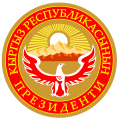
Back رئيس قرغيزستان Arabic Qırğızıstan Prezidenti Azerbaijani Президент на Киргизстан Bulgarian President del Kirguizstan Catalan Präsident der Kirgisischen Republik German Πρόεδρος της Κιργιζίας Greek Presidente de Kirguistán Spanish Kõrgõzstani president Estonian رئیسجمهور قرقیزستان Persian Kirgisian presidentti Finnish
| President of the Kyrgyz Republic | |
|---|---|
| Кыргыз Республикасынын Президенти (Kyrgyz) Президент Кыргызской Республики (Russian) | |
 Presidential seal | |
 Presidential standard | |
since 28 January 2021 | |
| Style | Mr. President (informally) Comrade Commander-in-Chief (military) His Excellency (international correspondence) |
| Status | Head of state Head of government |
| Member of | Cabinet Security Council |
| Residence | Yntymak Ordo, Bishkek |
| Seat | Bishkek, Kyrgyzstan |
| Appointer | Direct popular vote |
| Term length | 5 years, renewable once[1] |
| Constituting instrument | Constitution of Kyrgyzstan |
| Precursor | Chairmen of the Supreme Soviet of the Kirghiz SSR |
| Inaugural holder | Askar Akayev |
| Formation | 27 October 1990 |
| Salary | 1 281 609 som/US$ 14,660 annually[citation needed] |
| Website | president |
 |
|---|
|
|
| Constitution |
The president of Kyrgyzstan, officially the president of the Kyrgyz Republic,[a] is the head of state and head of government of the Kyrgyz Republic. The president directs the executive branch of the national government, is the commander-in-chief of the Kyrgyz military and also heads the National Security Council.
The president, according to the constitution, "is the symbol of the unity of people and state power, and is the guarantor of the Constitution of the Kyrgyz Republic, and of an individual and citizen."
The office of president was established in 1990 replacing the Chairman of the Supreme Soviet that existed, in different forms, from 1936 whilst the country was known as the Kirghiz Soviet Socialist Republic.
The first popularly elected officeholder was Askar Akayev, who served from October 1990 until 24 March 2005. In July 2005 after the Tulip Revolution, Kurmanbek Bakiyev was elected. He was re-elected in 2009, but large riots in April 2010 forced him to resign and flee the country. Roza Otunbayeva was selected in April 2010 to head the interim government. She was officially inaugurated on 3 July 2010, as president for a limited term, until elections could be organised. Her successor, Almazbek Atambayev, was elected in the 2011 Kyrgyzstani presidential election and subsequently succeeded Otunbayeva on 1 December that year.
On 16 October 2017, Sooronbay Jeenbekov, the former prime minister, was elected president of the country. He took office on 24 November 2017. On 15 October 2020, Jeenbekov resigned following unrest over the parliamentary elections on 4 October. Jeenbekov was succeeded by Prime Minister Sadyr Japarov, who became acting president before being confirmed as the 6th and current president on 16 October, and officially held the post on 28 January 2021.[2][3]
- ^ "Kyrgyzstan parliament approves referendum on new constitution". 11 March 2021.
- ^ "Kyrgyzstan president Jeenbekov resigns after unrest". Reuters. Retrieved 15 October 2020.
- ^ Merz, Theo (16 October 2020). "Ex-prisoner Sadyr Japarov confirmed as Kyrgyzstan president". The Guardian. Retrieved 18 October 2020.
Cite error: There are <ref group=lower-alpha> tags or {{efn}} templates on this page, but the references will not show without a {{reflist|group=lower-alpha}} template or {{notelist}} template (see the help page).
